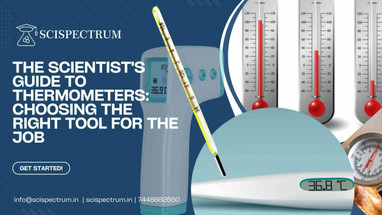Posted by Scispectrum on 22nd Aug 2025
The Scientific thermometers Guide to Thermometers: Choosing the Right Tool for the Job
Scientific thermometers Guide In the realm of exploration, precision is paramount. Every variable, every degree, every slightest fluctuation can influence the outcome of an experiment. Among these critical variables, temperature reigns supreme. Whether you’re a seasoned researcher or a budding scientist, understanding and selecting the right thermometer is fundamental to achieving accurate and reliable results. This guide delves into the intricacies of thermometers, equipping you with the knowledge to make informed decisions for your scientific endeavours.
The Crucial Role of Temperature in Scientific Inquiry
Scientific thermometers Guide Temperature acts as a silent orchestrator in countless scientific phenomena. It dictates the pace of chemical reactions, influences the physical properties of matter, and governs the delicate balance of biological systems. From determining the melting point of a newly synthesised compound to monitoring the growth rate of bacterial cultures, accurate temperature measurement is non-negotiable for obtaining meaningful data and drawing valid conclusions.

Navigating the World of Thermometers: A Comparative Overview
The world of thermometers extends far beyond the simple mercury thermometers we might remember from our school days. Let’s explore the diverse array of thermometers commonly employed in scientific settings:
1. Liquid-in-Glass Thermometers: The Classics
These traditional thermometers, often filled with mercury or alcohol, rely on the principle of thermal expansion. As the temperature rises, the liquid expands within a calibrated glass tube, providing a visual indication of the temperature. While simple and cost-effective, their accuracy can be limited, and they are not suitable for all temperature ranges.
2. Scientific thermometers Guide Digital Thermometers: Embracing Modernity
Digital thermometers utilize electronic sensors to measure temperature and display readings on a digital screen. They offer enhanced accuracy, faster response times, and often include convenient features like data logging and multiple measurement units. Their ease of use and versatility make them a staple in many laboratories.
3. Infrared Thermometers: Contactless Precision
Infrared thermometers measure the infrared radiation emitted by an object to determine its temperature. This non-contact method makes them ideal for measuring the temperature of moving objects, hazardous substances, or surfaces that are difficult to access directly. They are commonly used in fields like engineering, manufacturing, and healthcare.
4. Thermocouples: Champions of Extreme Temperatures
Thermocouples consist of two dissimilar metals joined together, forming a junction. When this junction is exposed to a temperature difference, a voltage is generated, which is proportional to the temperature. Thermocouples are known for their wide temperature range, durability, and suitability for extreme environments, making them invaluable in industrial settings and high-temperature research.
Matching the Thermometer to Your Needs: Factors to Consider
Selecting the right thermometer involves careful consideration of several factors beyond the basic temperature range:
1. Accuracy and Precision: The Cornerstones of Reliability
Accuracy refers to how close a thermometer’s reading is to the true temperature, while precision reflects the consistency and repeatability of its measurements. Choose a thermometer with accuracy and precision levels that meet the specific requirements of your experiments.
2. Response Time: Capturing Rapid Changes
Response time is the time it takes for a thermometer to adjust to a new temperature. If your experiments involve rapid temperature fluctuations, a thermometer with a fast response time is crucial for capturing accurate data.
3. Durability and Safety: Navigating Challenging Environments
Consider the durability of the thermometer, especially if it will be used in harsh environments, exposed to chemicals, or subjected to physical stress. Additionally, prioritise safety by selecting thermometers with features that minimise the risk of contamination or exposure to hazardous materials.
4. Cost and Value: Balancing Budget and Performance
Thermometers come in a wide price range, reflecting their features, accuracy, and durability. Determine your budget and prioritise the features that are essential for your research while ensuring that the chosen thermometer provides good value for its cost.
Conclusion: Equipping Yourself for Scientific Success
Selecting the right thermometer is an investment in the accuracy and reliability of your scientific endeavours. By understanding the different types of thermometers, their strengths and limitations, and the factors to consider during selection, you empower yourself to make informed decisions that align with your research goals. Remember to prioritise accuracy, precision, safety, and value, and always follow proper calibration and handling procedures to ensure optimal performance and longevity of your chosen instrument. With the right tools at your disposal, you’ll be well-equipped to unravel the mysteries of the scientific world, one precise measurement at a time.

